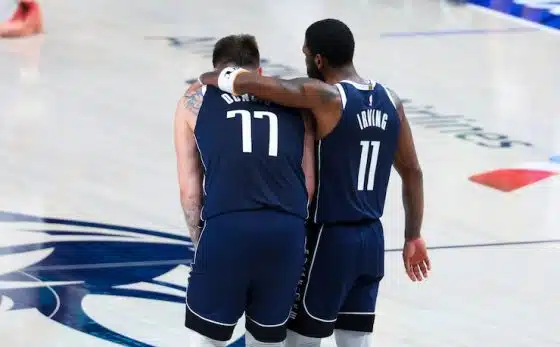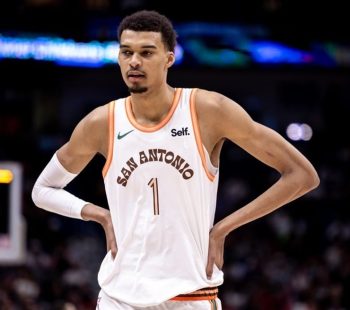NBA
Game 5 Was The Ultimate Affirmation Of The Luka Doncic-Kyrie Irving Experiment

Key Highlights
- Luka Doncic and Kyrie Irving combined for a playoff-best 72 points on 69.1 percent true shooting in the Dallas Mavericks‘ Game 5 victory over the Minnesota Timberwolves
- The Mavericks’ 129.8 offensive rating in the half-court was the second-highest mark Minnesota has allowed all season
- Doncic and Irving put on a shot-making extravaganza, attempting just seven free throws and going 28-of-49 (57.1 percent) from the floor
If the first quarter of Luka Doncic’s Game 5 — a 20-point showcase defined by snarls, competitive spirit, and deeper and deeper triples — thrust his Dallas Mavericks onto the last bridge before the NBA Finals, his running mate, Kyrie Irving, lugged them all across with his 25 points between the second and third quarters — a dizzying array of pull-up jumpers and trapeze artist finishes.
Together, the contrasting, complementary stars totaled 72 points on 49 shots. After the Minnesota Timberwolves knotted the game at 18 midway through the first, Doncic ignited a 17-1 run to close the first and extinguish any inkling of a return to American Airlines Center for Game 6. Minnesota never again drew closer than 16 and trailed by at least 20 the final 27.5 minutes. It was a complete pummeling, a no-doubt knockout.
As they were throughout the series, Doncic and Irving were easily the two best players in this game. Nobody else rivaled their effervescent greatness. The entire five-game stretch was a culmination of the Doncic-Irving pairing, but none more so than Game 5. Seventy-two combined points marked the duo’s most in 17 playoff games, and they did it while recording just three in the final frame.
Minnesota’s once-historic defense — a unit full of limbs, range, precision and versatility — spiraled in Game 5. Dallas generated 129.8 points per 100 possessions in the half-court, the second-highest number the Timberwolves conceded in any of their 98 games. Only a road back-to-back in mid-November against the Phoenix Suns in which the Suns went 17-of-31 from deep barred the Mavericks from taking home gold.
Doncic and Irving unraveled Minnesota’s defense all series. The Mavericks’ 119.4 offensive rating was 9.5 points higher than what the Timberwolves allowed the first two rounds (109.9) and 10.5 points higher than what they allowed during the regular season (108.9). As the two slalomed through Minnesota, consternation about the proper defensive schemes flooded the airwaves, both in-game, as well as before and after.
But here’s the thing: the Timberwolves legitimately tried about every single tactic possible. None of it consistently confined Doncic and Irving because they were simply too good. They were scheme-proof stars in this matchup. The gaudy offensive showing says far more about their greatness than Minnesota’s struggles, even if it committed a good deal more unforced mistakes than typical.
The best plan against Doncic is trusting whatever you’re running and executing it as well as possible. It’s a carbon-copy of the discussions centered around Nikola Jokic last postseason. These are two ethereal offensive talents, and Irving is pretty damn good himself. They’ve been in the league for more than half a decade. If there was some way to reliably curb them, it would be popularized by now.
In Game 5, the depths of Doncic and Irving’s brilliance shone bright. They found success against every decision the Timberwolves settled on. It was a perfect encapsulation of the lengths Minnesota wandered toward all series to try and slow these two, only for them to ultimately win out time after time.
To kick off the night, Dallas ran a Zoom action for Doncic and Anthony Edwards top-locked him, so Doncic cut backdoor, forced a switch onto Mike Conley Jr. and scored.
Much like Game 4, Rudy Gobert regularly played drop coverage, especially early on, and Minnesota instructed its point-of-attack defenders to chase ball-handlers over the top. Part of the reason Dallas struggled offensively in Game 4 was because the Timberwolves brought aggressive help from the wings and as low men than at any other point in the series.
Drop is Minnesota’s base gambit, but usually without such drastic help, often playing two-on-two and staying home in the corners/on the wings. The shift briefly threw the Mavericks’ stars off-kilter.
That strategy continued Thursday, but Doncic and Irving were better prepared. Ball-screens were initiated higher up. The wing on whichever side they intended to drive was cleared. They trusted their dexterous handle to mitigate help and let them reach their spots. If gap help did come from the wing, whoever was stationed there knew to swiftly shoot or drive off the catch.
Dallas also tweaked its game-plan and mindset versus gap help, often slotting Doncic or Irving one pass away from the other to account for it. Periodically, Doncic whisked past — aware it was more of a hollow threat than a staunch commitment to actually leave the strong-side.
Going over screens invited paint touches for a pair of prolific paint scorers. So, occasionally, Minnesota opted to duck under those screens. But that didn’t lend itself to much success either.
Not only are they tremendous downhill dashers, they’re pull-up demons, too, and going under afforded them the space to tee off. Doncic won’t jack 40-foot bombs all the time, yet his immediate willingness to fire illuminates how ready he was for every coverage enforced his direction in this series and game.
(You can ignore the second clip above, the first is what matters when Kyle Anderson slips under the pick).
Another time, Edwards employed a no-middle approach against Doncic. He Iced the screen, forcing Daniel Gafford to flip the angle and funnel Doncic toward Gobert, who deviated from his traditional drop and hovered around the level of the screen momentarily. Edwards saunters under the screen and is a bit late recovering back to Doncic, who bangs home another long ball from way out.
Midway through the second quarter, Gobert returned to the level, while the point-of-attack defender, Anderson, chased over the top. Dereck Lively III’s hard-nosed screen leaves Anderson behind the play and Dallas strategically put Derrick Jones Jr. in the weakside corner, which forced Conley into low man responsibilities. Anderson doesn’t discourage the pocket pass once he’s reattached to Doncic and Conley has to foul to prevent an easy bucket.
Virtually all series, if Karl-Anthony Towns was involved as a primary ball-screen big, the Timberwolves elected to hedge. He’s a poor drop defender, beset by ground-bound hops and poor quick-twitch muscles.
But he also struggled immensely in hedge situations and Dallas exploited that, notably when he anchored the middle without Gobert around to insulate him. The Mavericks yielded some really good stuff in Game 5 working behind hedges from Towns.
Following intermission, as the mortality of a carpet-ride season approached, Minnesota started blitzing some of Doncic’s touches. Prior to halftime, Irving saw some hard shows on the catch before the second defender retreated into single coverage. Neither double-team — fleeting or steadfast — bottled up this Texas two-step.
Lively — whose short-roll savvy have been integral in the playoffs — primed Irving for a catch-and-shoot triple. On the second play, Irving waited out help, charged into the lane, and arced in a 6-foot leaner (note how Doncic’s positioning neutralizes any chance for Edwards to help on Irving’s drive).
In the fourth, with Gobert sitting as Minnesota trotted out an offensive-minded lineup, it began switching Towns onto the perimeter. Every other idea had been exhausted: dropping, hedging, blitzing, doubling, Icing, playing at the level, chasing over, going under, gap help and staying home.
None of it perplexed them, so the final desperate attempt for a solution was to switch. That, too, failed.
The widespread nature with which Doncic and Irving dismantled the league’s premier defense popped for its versatility of style, both in the coverages faced and the scoring signatures penned. They flourished in pick-and-rolls. They prospered in isolation. They concisely operated off the catch. They dabbled in fast-break forays.
It wasn’t just about lighting the entirety of Minnesota’s pick-and-roll playbook ablaze; it was also about displaying its multifaceted delivery. Game 5 felt like a summation of Doncic’s resolute mastery and the tweaks he’s embraced to reach his inaugural NBA Finals. The on-ball wizardry persisted, but his growth as an off-ball cog and the ways he’s adapted to best accommodate Irving glimmered.
His decision-making off the catch was tremendous. He launched spot-up jumpers; a playoff career-high 9.5 percent of his triples are via catch-and-shoots (previous high was 4.8) and he’s netting 36.1 percent of them. He drove the lane when the ball swung toward him. Both as a facilitator and slasher, he pushed the tempo for easy open-floor chances.
This Finals-bound partnership couldn’t be maximized without those adjustments, and they were most evident in Game 5. Even if Irving is the more frequent off-ball scorer, they each benefited from one another’s eyeball-inducing orbit.
Doncic and Irving, while exceptionally gifted offensive conductors, are radically different players of makeup and skill-set.
The former is a sturdy, methodical wing whose first step is dwarfed in value by his final step and holsters the passing vision of an owl — cognizant of every possibility at every opportunity. The latter is a guard who glides like a rock skipping along the pond and wields creative randomness as his sharpest tool. A defender wired to blanket one is probably not wired to blanket the other, let alone both.
Labeling them unbelievable shot-makers isn’t so much inaccurate as it is miscasting their rarity. The undercurrent of their triumphs is problem-solving. They are trivia night wunderkinds — taking turns answering every question, sometimes in tandem and sometimes individually.
It’s what distinguished them from Minnesota’s offensive hubs, two bright stars in their own regard who rarely functioned together and owned far fewer answers for what the looming, creeping, pressuring defense presented on the other side. Never did that ring louder than Thursday, the preeminent game of this increasingly successful experiment between Luka Doncic and Kyrie Irving.














